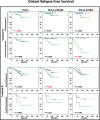PLC-gamma-1 phosphorylation status is prognostic of metastatic risk in patients with early-stage Luminal-A and -B breast cancer subtypes
- PMID: 31362705
- PMCID: PMC6668079
- DOI: 10.1186/s12885-019-5949-x
PLC-gamma-1 phosphorylation status is prognostic of metastatic risk in patients with early-stage Luminal-A and -B breast cancer subtypes
Abstract
Background: Phospholipase Cγ1 (PLCγ1) is highly expressed in human tumours. Our previous studies reported that both stable and inducible PLCγ1 down-regulation can inhibit formation of breast-cancer-derived experimental lung metastasis. Further, high expression of PLCγ1 and its constitutively activated forms (i.e., PLCγ1-pY1253, PLCγ1-pY783) is associated with worse clinical outcome in terms of incidence of distant metastases, but not of local relapse in T1-T2, N0 breast cancer patients.
Methods: In the present retrospective study, we analysed the prognostic role of PLCγ1 in early breast cancer patients stratified according to the St. Gallen criteria and to their menopausal status. PLCγ1-pY1253 and PLCγ1-pY783 protein expression levels were determined by immunohistochemistry on tissue microarrays, and were correlated with patients' clinical data, using univariate and multivariate statistical analyses.
Results: In our series, the prognostic value of PLCγ1 overexpression was restricted to Luminal type tumours. From multivariate analyses, pY1253-PLCγ1High was an independent prognostic factor only in postmenopausal patients with Luminal-B tumours (hazard ratio [HR], 2.4; 95% confidence interval [CI], 1.1-5.3; P = 0.034). Conversely, PLCγ1-pY783High was a remarkably strong risk factor (HR, 20.1; 95% CI, 2.2-178.4; P = 0.003) for pre/perimenopausal patients with Luminal-A tumours.
Conclusions: PLCγ1 overexpression is a strong predictive surrogate marker of development of metastases in early Luminal-A and -B breast cancer patients, being able to discriminate patients with high and low risk of metastases. Therefore, targeting the PLCγ1 pathway can be considered of potential benefit for prevention of metastatic disease.
Keywords: Breast cancer; Luminal subtypes; Menopausal status; Phospholipase Cγ1; Prognosis.
Conflict of interest statement
The authors declare that they have no competing interests.
Figures





Similar articles
-
Overexpression of activated phospholipase Cγ1 is a risk factor for distant metastases in T1-T2, N0 breast cancer patients undergoing adjuvant chemotherapy.Int J Cancer. 2013 Mar 1;132(5):1022-31. doi: 10.1002/ijc.27751. Epub 2012 Sep 1. Int J Cancer. 2013. PMID: 22847294
-
Histological grade provides significant prognostic information in addition to breast cancer subtypes defined according to St Gallen 2013.Acta Oncol. 2017 Jan;56(1):68-74. doi: 10.1080/0284186X.2016.1237778. Epub 2016 Oct 20. Acta Oncol. 2017. PMID: 27762648 Clinical Trial.
-
St Gallen molecular subtypes in primary breast cancer and matched lymph node metastases--aspects on distribution and prognosis for patients with luminal A tumours: results from a prospective randomised trial.BMC Cancer. 2013 Nov 25;13:558. doi: 10.1186/1471-2407-13-558. BMC Cancer. 2013. PMID: 24274821 Free PMC article.
-
Current and potential immunohistochemical biomarkers for prognosis and therapeutic stratification of breast carcinoma.Semin Cancer Biol. 2021 Jul;72:114-122. doi: 10.1016/j.semcancer.2020.03.002. Epub 2020 Mar 9. Semin Cancer Biol. 2021. PMID: 32165319 Review.
-
Luminal Breast Cancer: Risk of Recurrence and Tumor-Associated Immune Suppression.Mol Diagn Ther. 2021 Jul;25(4):409-424. doi: 10.1007/s40291-021-00525-7. Epub 2021 May 11. Mol Diagn Ther. 2021. PMID: 33974235 Free PMC article. Review.
Cited by
-
TRP Channels Interactome as a Novel Therapeutic Target in Breast Cancer.Front Oncol. 2021 Jun 10;11:621614. doi: 10.3389/fonc.2021.621614. eCollection 2021. Front Oncol. 2021. PMID: 34178620 Free PMC article.
-
Phosphoinositide-Dependent Signaling in Cancer: A Focus on Phospholipase C Isozymes.Int J Mol Sci. 2020 Apr 8;21(7):2581. doi: 10.3390/ijms21072581. Int J Mol Sci. 2020. PMID: 32276377 Free PMC article. Review.
-
Biological activity and molecular docking studies of some new quinolines as potent anticancer agents.Med Oncol. 2021 Jun 19;38(7):84. doi: 10.1007/s12032-021-01530-w. Med Oncol. 2021. PMID: 34146171
-
Senescent Secretome of Blind Mole Rat Spalax Inhibits Malignant Behavior of Human Breast Cancer Cells Triggering Bystander Senescence and Targeting Inflammatory Response.Int J Mol Sci. 2023 Mar 7;24(6):5132. doi: 10.3390/ijms24065132. Int J Mol Sci. 2023. PMID: 36982207 Free PMC article.
-
Phosphorylation of PLCγ1 by EphA2 Receptor Tyrosine Kinase Promotes Tumor Growth in Lung Cancer.Mol Cancer Res. 2020 Nov;18(11):1735-1743. doi: 10.1158/1541-7786.MCR-20-0075. Epub 2020 Aug 4. Mol Cancer Res. 2020. PMID: 32753469 Free PMC article.
References
MeSH terms
Substances
LinkOut - more resources
Full Text Sources
Medical
Research Materials
Miscellaneous

